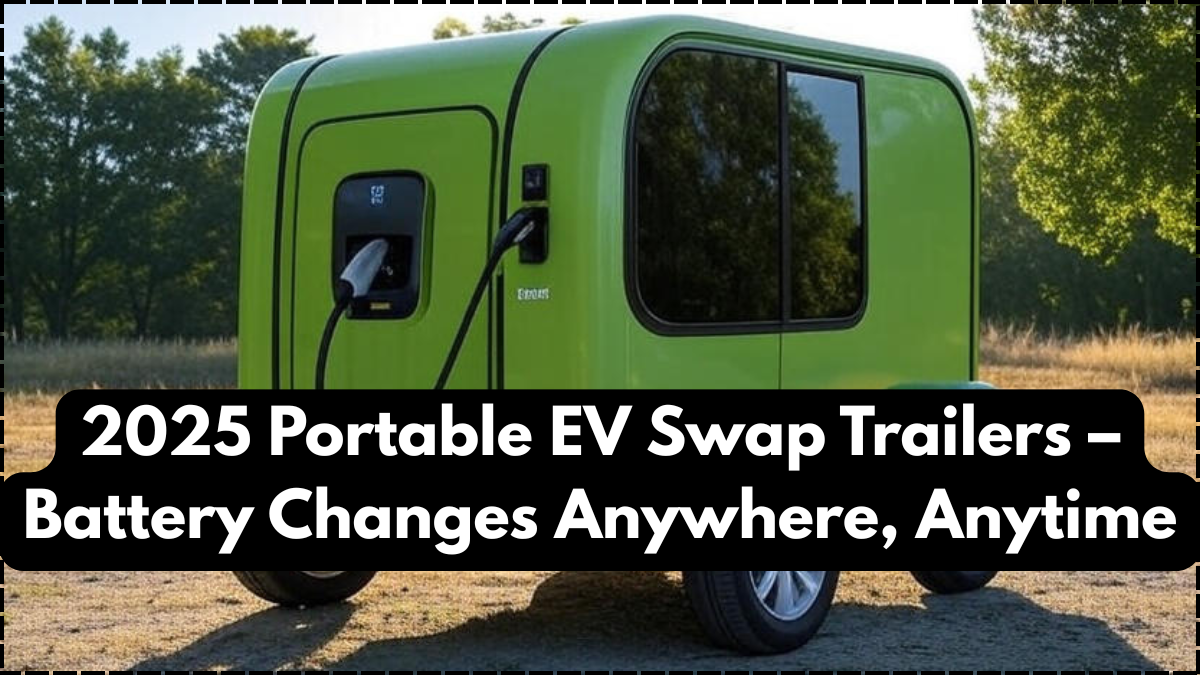Portable EV Swap Trailers are becoming a breakthrough solution for the growing electric vehicle ecosystem. As EV adoption increases rapidly in 2025, the challenge of charging infrastructure remains a major concern. Not every highway or rural road has fast-charging stations, which creates range anxiety for drivers. This is where Battery-on-the-Go 2025 plays a transformative role—by introducing mobile trailers that carry fully charged batteries and allow instant swaps on the road. These trailers promise to revolutionize convenience, efficiency, and reliability for EV owners across the country.

Why Portable EV Swap Trailers Are Needed
While EVs are celebrated for being eco-friendly, charging remains time-consuming and often inaccessible in remote areas. Portable solutions like Portable EV Swap Trailers address this issue by eliminating long wait times at charging stations. Instead of plugging in and waiting, drivers can swap a drained battery for a fully charged one in just minutes. This aligns with the Battery-on-the-Go 2025 vision to make clean mobility more practical, faster, and universally available.
How Portable EV Swap Trailers Work
The technology behind these trailers is simple but highly effective. Each trailer is equipped with racks of pre-charged batteries, a swapping mechanism, and smart tracking systems. When an EV runs low on charge, drivers can either visit a trailer stationed along highways or request mobile services that bring the trailer directly to them. This makes Portable EV Swap Trailers flexible and reliable. As part of Battery-on-the-Go 2025, these trailers are expected to be integrated with apps that let users track availability and reserve a swap in advance.
Key features include:
- Mobile trailers with multiple fully charged batteries.
- Swap completed in under 10 minutes.
- Integration with EV apps for booking and payment.
- Ability to serve highways, urban areas, and rural regions.
- Reduction of charging station overload.
Comparing Charging vs. Swapping
EV charging can often take 30 minutes to several hours depending on the type of charger, while swapping offers a much faster alternative. The table below compares traditional charging with Portable EV Swap Trailers under the Battery-on-the-Go 2025 initiative:
Factor |
Traditional EV Charging |
Portable EV Swap Trailers |
|---|---|---|
Time Required |
30 minutes to 6 hours |
Under 10 minutes |
Infrastructure Needs |
Permanent charging stations |
Mobile trailers |
Accessibility |
Limited to specific locations |
Available anywhere |
Convenience |
Waiting required |
Instant battery swap |
Battery-on-the-Go 2025 Role |
Secondary focus |
Central innovation |
This shows why battery swapping is seen as the future of EV mobility.
Benefits for Drivers and Communities
The introduction of Portable EV Swap Trailers is not only a convenience for drivers but also a boost for the entire EV ecosystem. Drivers enjoy peace of mind, knowing they can always find a quick solution when low on power. Communities benefit as well, since the spread of Battery-on-the-Go 2025 makes EV adoption more attractive and practical. Moreover, swapping technology reduces grid load by charging batteries during off-peak hours and deploying them when needed.
Some additional benefits include:
- Faster adoption of EVs in rural areas.
- Reduced downtime for commercial fleets.
- Job creation in trailer operations and battery management.
- Support for government sustainability goals.
Conclusion
The year 2025 marks a turning point in EV infrastructure, with Portable EV Swap Trailers leading the way. By supporting the Battery-on-the-Go 2025 initiative, these mobile solutions are ensuring that no driver is stranded due to lack of charging options. With their speed, flexibility, and accessibility, swap trailers are set to play a crucial role in accelerating EV adoption across cities, towns, and highways. They are not just a convenience—they are the backbone of the next stage in sustainable mobility.
FAQs
What are Portable EV Swap Trailers?
They are mobile trailers carrying fully charged EV batteries that can be swapped instantly with drained ones.
How do they support Battery-on-the-Go 2025?
They are the core of the Battery-on-the-Go 2025 mission, making battery swapping faster and available anywhere.
How long does it take to swap a battery?
The process takes less than 10 minutes, much faster than traditional charging.
Can these trailers serve rural areas?
Yes, their mobility allows them to serve both urban highways and rural regions without fixed infrastructure.
Why are Portable EV Swap Trailers important for 2025?
Because they solve charging challenges, reduce range anxiety, and encourage faster EV adoption across the country.
Click here to learn more